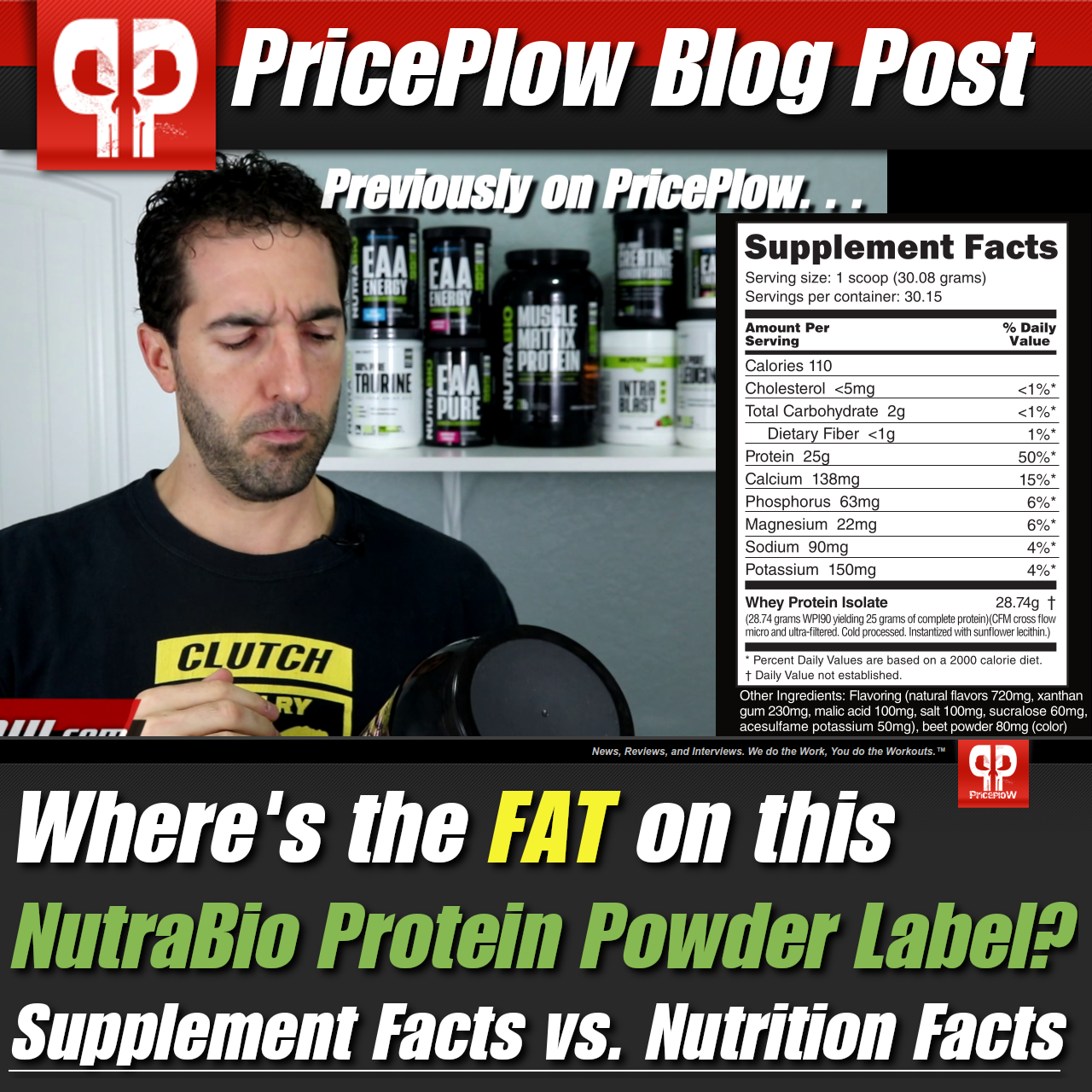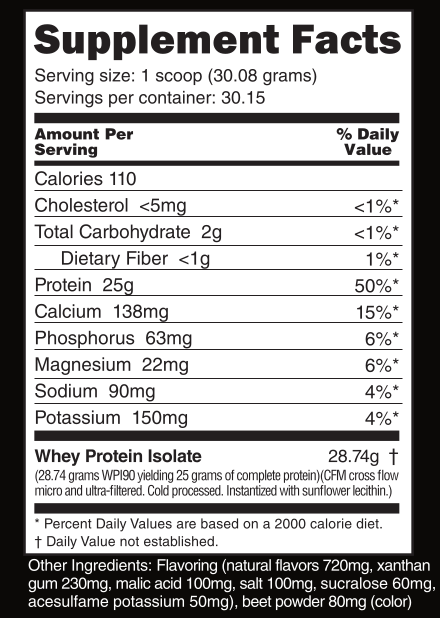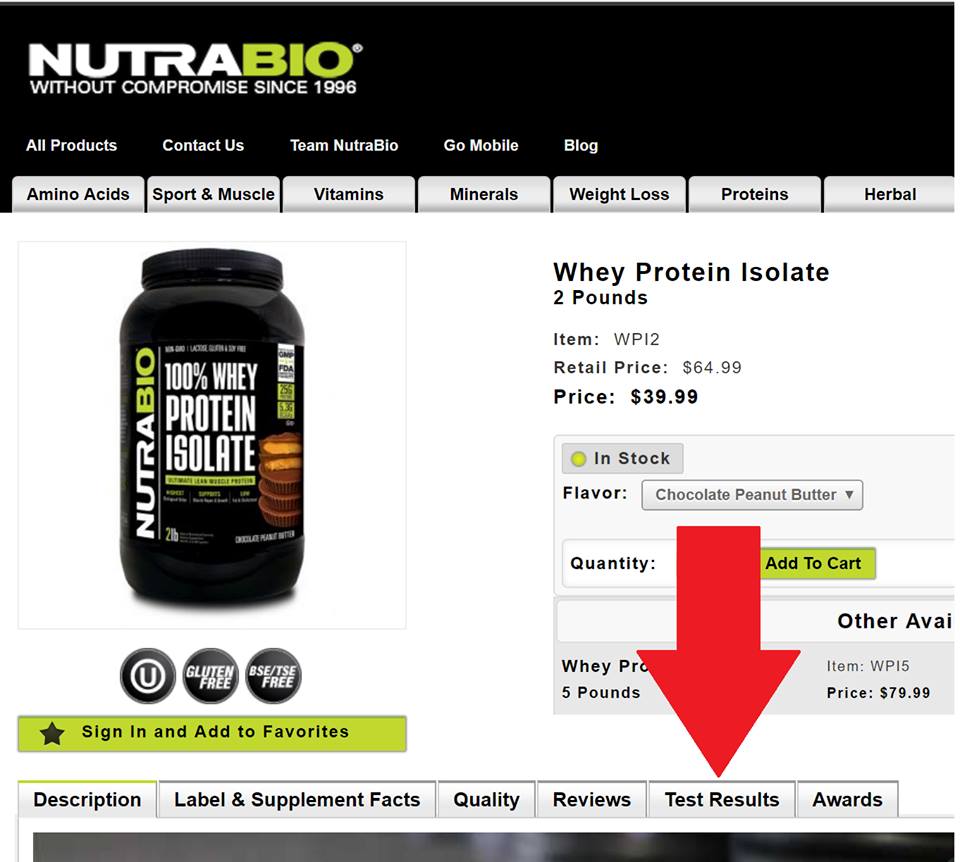
What did I screw up this time? Turns out there's some legal differences between a Supplement Facts panel and a Nutrition Facts panel!
Last week, when I was reviewing the new Strawberry Ice Cream flavor of NutraBio's 100% Whey Protein Isolate, I stumbled on something "odd" when I was going over the label. I couldn't find fat!
What gives? Where is the fat on the label? Was this a mistake?
I contacted NutraBio CEO Mark Glazier, asking if they missed something.
It turns out that I was the one missing something, and it was not a mistake. NutraBio was following the letter of the law.
Supplement Facts vs. Nutrition Facts on Protein Powders
You can read the blog post below and check out the citations, or follow along in our video:
Now on to today's knowledge bomb:
Protein powders are unique in that they work both as supplements and as foods. As such, companies can choose to label them with a Supplement Facts panel or a Nutrition Facts panel.

The FDA has separate requirements for Supplement Facts and Nutrition Facts panels. Protein manufacturers can choose which one to use!
If you have a few tubs of protein in your house, go take a look at them. You may see one or the other. Of the several tubs I have here for testing, the majority are using Nutrition Facts, but there are some advantages for brands using Supplement Facts.
On a Guidance for dietary supplement labeling,[1] the FDA distinguishes five major differences:
The major differences between "Supplement Facts" panel and "Nutrition Facts" panel are as follows:
- You must list dietary ingredients without RDIs or DRVs in the "Supplement Facts" panel for dietary supplements. You are not permitted to list these ingredients in the "Nutrition Facts" panel for foods.
- You may list the source of a dietary ingredient in the "Supplement Facts" panel for dietary supplements. You cannot list the source of a dietary ingredient in the "Nutrition Facts" panel for foods.
- You are not required to list the source of a dietary ingredient in the ingredient statement for dietary supplements if it is listed in the "Supplement Facts" panel.
- You must include the part of the plant from which a dietary ingredient is derived in the "Supplement Facts" panel for dietary supplements. You are not permitted to list the part of a plant in the "Nutrition Facts" panel for foods.
- You are not permitted to list "zero" amounts of nutrients in the "Supplement Facts" panel for dietary supplements. You are required to list "zero" amounts of nutrients in the "Nutrition Facts" panel for food.
21 CFR 101.36(b)(3) and (b)(2)(i), 21 CFR 101.4(h), 21 CFR 101.36(d) and (d)(1), and 21 CFR 101.9
-- United States Food and Drug Administration[1] (emphasis ours)
I've bolded the two that are relevant to our situation. Part (e) is the part that says you may not list "zero" if using a supplement facts panel. Since this is indeed what's on NutraBio's 100% Whey Protein Isolate product, Mark Glazier and team are indeed following the law correctly.
Note that the guideline cited above is not a law. If you want to go even further, you can find the regulation it cites, CFR 101.36(b)(2)(i),[2] which states
Any (b)(2)-dietary ingredients that are not present, or that are present in amounts that can be declared as zero in §101.9(c), shall not be declared (e.g., amounts corresponding to less than 2 percent of the RDI for vitamins and minerals).-- CFR 101.36(b)(2)(i)[2]
In the above area, a "(b)(2)-dietary ingredient" means the following:
- Total calories
- Calories from fat
- Total fat
- Saturated fat
- Trans fat
- Cholesterol
- Sodium
- Total carbohydrate
- Dietary fiber
- Sugars
- Protein
- Vitamin A
- Vitamin C
- Calcium
- Iron
But isn't this confusing? Why would they want to do that?
So why would a company want to choose to do this? Someone like me who scours the labels could get confused (or worse - think that something devious is happening). And beside, wouldn't it be better to show off that beautiful "0g Fat" on the label?
The answer is NutraBio's mission of full label disclosure. We've discussed this a ton in the past, and you can learn more about it in The NutraBio Story, where we have several interviews with Mark Glazier.
This brings us back to the differences between Supplement Facts and Nutrition Facts listed above.
Recall this part:
You may list the source of a dietary ingredient in the "Supplement Facts" panel for dietary supplements. You cannot list the source of a dietary ingredient in the "Nutrition Facts" panel for foods.[1]
Digging into the specific regulation cited, 21 CFR 101.36(d), we see this:
The source ingredient that supplies a dietary ingredient may be identified within the nutrition label in parentheses immediately following or indented beneath the name of a dietary ingredient and preceded by the words ‘‘as’’ or ‘‘from’’, e.g., ‘‘Calcium (as calcium carbonate),’’...
-- 21 CFR 101.36(d)[2]
We can't speak for other companies or for all of NutraBio's reasoning, but this is at least a major part of it:
NutraBio's disclosing the source!!

This is the Strawberry Ice Cream label for NutraBio's 100% Whey Protein Isolate. Crazy that you won't see fat here, but now you know!
If you want full label disclosure, you have to tell us exactly where the protein is coming from in parenthesis. On NutraBio's label, they state the following:
Whey Protein Isolate 28.84g
(28.74 WPI90 yielding 25 grams of complete protein)(CFM cross flow micro and ultra-filtered. Cold processed. Instantized with sunflower lecithin.)
So this is how you can honestly list the source of the exact dietary ingredient in the Supplement Facts area -- which is probably where it belongs to the consumer -- and not some general "Ingredients" or "Other Ingredients" area.
There could be other reasons for using the Supplement Facts panel here, but this seems to be a major one.
Addendum: CFR 111 (Supplement Facts) vs. CFR 110 (Nutrition Facts)
After watching my video above, Mark Glazier called me to say one other major reason - "Supplement Facts" panels fall under CFR 111, which is better for the consumer. Reason being, you must test for identity, potency, purity, and composition of each active ingredient listed there.
So when you put exactly what you have on a supplement facts panel (as NutraBio does with their protein shown above), you must test it and be able to prove it out. When doing this, it's even better for the consumer.
With a food-based product falling under CFR 110 (for "Nutrition Facts" panels), the macros need to test out, but there's less identity testing required behind the scenes. For instance, a food company is not beholden to proving a certain amount of flour in their foodstuff (like a donut). NutraBio customers demand more, and they get it with a Supplement Facts panel that has all active ingredients listed -- and tested for.
Don't forget, NutraBio also shares third-party lab testing outside of what they do in-house!
Regarding Structure/Function Claims
Another note: If a brand is marketing it as a “structure/function claim,” the FDA states that you must show the disclaimer[3,4] (that you've probably seen a ton of times) stating that:
This statement has not been evaluated by the Food and Drug Administration. This product is not intended to diagnose, treat, cure, or prevent any disease.
-- 403(r)(6)(C)[5]
However, structure/function claims on foods don't require that disclaimer!
Thanks Mark Glazier and NutraBio
I'd like to take this moment to thank Mark Glazier for educating me on one of the busiest days of the year, when he was preparing for Black Friday and Cyber Monday. He quickly clarified the fact that Supplement Facts panels can't list "0g" on the label, and we were able to make edits to the video in time before publishing.
After that, the rest of the digging on this post is my own, and some assumptions have been made regarding Full Label Disclosure.
Anyway, if you're looking for a zero-fat* protein powder, look no further than the upcoming new flavors of NutraBio's 100% Whey Protein Isolate!
NutraBio Whey Protein Isolate – Deals and Price Drop Alerts
Get Price Alerts
No spam, no scams.
Disclosure: PricePlow relies on pricing from stores with which we have a business relationship. We work hard to keep pricing current, but you may find a better offer.
Posts are sponsored in part by the retailers and/or brands listed on this page.
*In the spirit of full transparency, the honest truth is that there's probably about ~0.2g fat in 29g of WPI-90. But per the law, that gets rounded to "zero", and is thus left off a Supplement Facts panel!





Comments and Discussion (Powered by the PricePlow Forum)